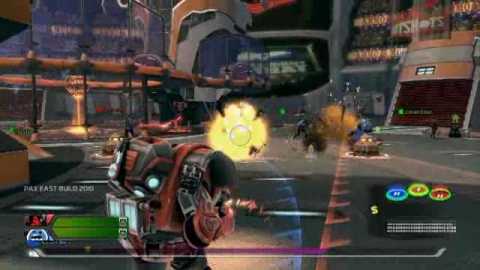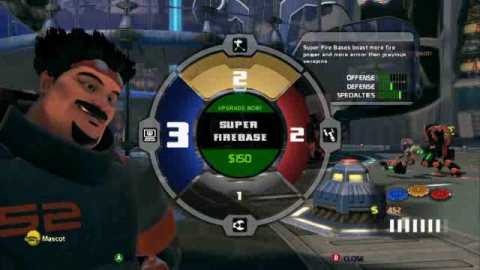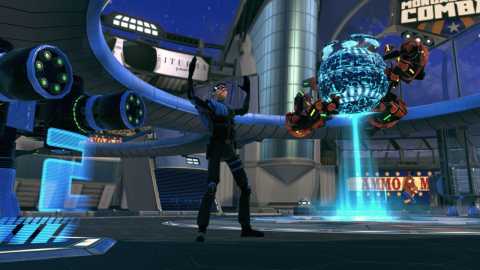
The easy shorthand for this game is "Team Fortress 2 meets Defense of the Ancients," the sort of lazy description I'd normally shy away from if it weren't so damn accurate. It's got the exaggerated art style and broad mix of specialized classes from the former, and the battlefield layout and gameplay flow of the latter. Turns out, those are in fact two multiplayer tastes that taste grea... well, let's say the developer has done a great job of integrating those two halves into a cohesive whole.
As you might guess from the name, Monday Night Combat is shot through with the feel of a futuristic death sport, and the main competitive mode, Crossfire, is set up in a six-on-six format. Each team has a goal called the moneyball to defend back at their base, with a bunch of nodes scattered around it where you can cash in money you pick up to build turrets that shoot lasers, rockets, mortars, or enemy-slowing freeze rays. You can also spend that money on upgrades for your own character, so there's a constant balancing act between helping out your team's defenses and boosting your own combat prowess. Both tactics pay off in different ways; the challenge is mostly in knowing when it's best to use which one.

With all these options, it's immensely satisfying to set up workable defenses, mix your classes properly, work together, and progressively push the line of conflict forward. Conversely it's frustrating as hell when your team doesn't know what it's doing and everyone runs around aimlessly while a coordinated enemy steamrolls right over you. In short, the game is subject to the same strict requirement to know what the hell you're doing as every other team-based game, but you can't really hold that against the game itself. It has a high learning curve, but there are really extensive video and text tutorials to ramp you up quickly.
There are also a lot of options in how you play, with six classes that fall into standard team-based archetypes. Here, let me list them and let's see if you can tell roughly what role they're supposed to fill. Assault, sniper, gunner, assassin, support, tank. Self-explanatory, right? Each class has two weapons and several neat abilities: the support can heal teammates and call down airstrikes, the assassin can dash and cloak for stealth kills, the gunner can do a ground-pound slam attack and turn himself into a living turret. A big part of successful strategy is getting everyone to play their class well and use their abilities to complement each other and form a united front.

That wasn't the only questionable spot I ran into. As good as the core concepts in Monday Night Combat are, this is at times a rough-looking game. The frame rate can dip to almost unmanageable levels when there's too much going on. There are some weird animation bugs; character models who catch on fire or have angels circling their heads during a stun tend to retain those graphical effects long after the debuffs themselves have expired. And the general user experience feels a bit shoddy, with some design elements that pop from low to high resolution when you change menus, some fonts that don't fit very well in their containers, and the like. It's nothing that makes the game less fun overall, but it does give the impression that the game was built fairly quickly by a small team, which it was.
That's also Monday Night Combat's strength, though; it's lean, cheap, and focused, but it still offers a great multiplayer formula that feels like more than its component parts. Get a few friends together who are ready to learn the ins and outs of the available classes and tactics, and there's enough depth here to keep you playing for a good long while after you've gotten your $15 worth.